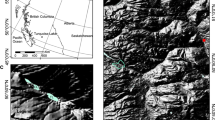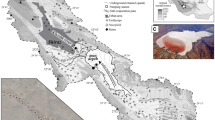Abstract
A multi-proxy analysis of two sediment cores from Rantin Lake are used to reconstruct past lake-level changes and to make inferences about millennial-scale variations in precipitation/evaporation (P/E) balance in the southern Yukon, Canada between 10,900 and 3,100 cal yr BP. Analyses of calcium carbonate and organic matter concentration, magnetic susceptibility, titanium content, dry bulk density, and macrofossils are used to reconstruct water-level changes. The development of sand layers and deformed sediments at the deep-water core site (i.e. Core A-06) prior to ~10,900 cal yr BP suggest that lake level was lower at this time. Fine-grained organic sediment deposited from 10,600 to 9,500 cal yr BP indicates a rise in lake level. The formation of an unconformity at the shallow cores site (Core C-06) and the deposition of shallow-water calcium carbonate-rich facies at the Core A-06 site between ~9,500 and ~8,500 cal yr BP suggest lower lake levels at this time. Shallow-water facies gradually transition into a sand layer that likely represents shoreline reworking during an extreme lowstand that occurred at ~8,400 cal yr BP. Following this low water level, fine-grained organic-rich sediment formed by ~8,200 cal yr BP, suggesting deeper water conditions at core site A-06. Calcium carbonate concentrations are relatively low in sediment deposited from ~6,300 to 3,100 cal yr BP in Core A-06, indicating that lake level was comparatively higher during the middle and late Holocene. In general, results from this study suggest that the early Holocene was characterized by high P/E from ~10,500 to 9,500 cal yr BP, low P/E from ~9,500 to 8,400 cal yr BP, and return to higher P/E from ~8,200 to 3,100 cal yr BP.






Similar content being viewed by others
References
Abbott MB, Strafford TW (1996) Radiocarbon geochemistry of ancient and modern lakes, Arctic lakes, Baffin Island. Quat Res 45:300–311
Abbott MB, Finney BP, Edwards ME, Kelts KE (2000) Lake-level reconstructions and paleohydrology of Birch Lake, central Alaska, based on seismic reflection profiles and core transects. Quat Res 53:154–166
Anderson L, Abbott MB, Finney BP, Edwards ME (2005) Palaeohydrology of the southwest Yukon Territory, Canada, based on multiproxy analyses of lake sediment cores from a depth transect. The Holocene 15:1172–1183
Benson L, White LD, Rye R (1996) Carbonate deposition, Pyramid Lake Subbasin, Nevada: 4. Comparison of the stable isotope values of carbonate deposits (tufas) and the Lahontan lake-level record. Palaeogeogr Palaeoclimatol Palaeoecol 122:45–76
Blaauw M (2010) Methods and code for ‘classical’ age-modelling of radiocarbon sequences. Quat Geochron 5:512–518
Bryson RA, Hare KF (1974) Climate of North America. In: Landsberg HE (ed) World survey of climatology. Elsevier, Amsterdam, pp 5–12
Clague JJ, Menounos B, Osborn G, Luckman BH, Koch J (2009) Nomenclature and resolution in Holocene glacial chronologies. Quat Sci Rev 28:2231–2238
Croudace IW, Rindby A, Rothwell RG (2006) ITRAX: description and evaluation of a new multi-function X-ray core scanner. In: New techniques in sediment core analysis. Geological Society Special Publications, London, pp 51–63
Cwynar LC, Spear RW (1995) Paleovegetation and paleoclimatic changes in the Yukon at 6 ka BP. Geogr Phys Quat 49:29–35
Dean WE (1974) Determination of carbonate and organic matter in calcareous sediments and sedimentary rocks by loss on ignition: comparison with other methods. J Sed Petr 44:242–248
Dean WE (2006) Characterization of organic matter in lake sediments from Minnesota and Yellowstone National Park. In: Open File Report 2006-1053, US Geological Survey Report, Reston, Virginia, p 40
Doherty RA, Mougeot CM, vanRanden JA (1994) Geological processes and terrain hazards of Watson Lake 105A. Exploration and geological services division, Yukon Region, Indian and Northern Affairs, Whitehorse, Yukon, Canada
Environment Canada (2010) Canadian Climate Normals 1971-2000, Watson Lake A, 2011 Fredericton, New Brunswick, Canada
Heiri O, Lotter AF, Lemcke G (2001) Loss on ignition as a method for estimating organic and carbonate content in sediments: reproducibility and comparability of results. J Paleolimnol 25:101–110
Kelts KE, Hsü KJ (1978) Freshwater carbonate sedimentation. In: Lakes AL (ed) Chemistry, geology, and physics. Springer, New York, pp 295–323
Koch J, Osborn GD, Clague JJ (2007) Pre-’Little Ice Age’ glacier fluctuations in Garibaldi Provincial Park, Coast Mountains, British Columbia, Canada. The Holocene 17:1069–1078
Leng M, Marshall JD (2004) Palaeoclimate interpretation of stable isotope data from lake sediment archives. Quat Sci Rev 23:811–831
Lipovsky PS, McKenna K, Huscroft CA (2005) Surficial geology of Watson Lake (NTS 105A/2), Yukon (1:50,000). Yukon Geological Survey, Energy, Mines, and Resources, Yukon Government, Open File 2005–7
Mock CJ, Bartlein PJ, Anderson PA (1998) Atmospheric circulation patterns and spatial climatic variations in Beringia. Int J Clim 10:1085–1104
Osborn G, Menounos B, Koch J, Clague JJ, Vallis V (2007) Multi-proxy record of Holocene glacial history of the spearhead and Fitzsimmons ranges, southern British Columbia. Quat Sci Rev 26:479–493
Sanford WE, Wood WW (1991) Brine evolution and mineral deposition in hydrologically open evaporite basins. Am J Sci 291:687–710
Shapley MD, Ito E, Donovan JJ (2005) Authigenic calcium carbonate flux in groundwater-controlled lakes: implications for lacustrine paleoclimate records. Geochim Cosmochim Acta 69:2517–2533
Streten NA (1974) Some features of the summer climate of interior Alaska. Arctic 27:272–286
Stuiver M, Reimer PJ, Bard E, Beck JW, Burr GS, Hughen KA, Kromer B, McCormac FG, vd Plicht J, Spurk M (1998) INTCAL98 Radiocarbon age calibration 24,000–0 cal BP. Radiocarbon 35:215–230
Stuiver M, Reimer PJ, Reimer R (2010) CALIB Radiocarbon Calibration INCAL09 dataset. http://calib.qub.ac.uk/calib/
Teller JT, Last WM (1990) Paleohydrological indicators in playas and salt lakes, with examples from Canada, Australia, and Africa. Palaeogeogr, Palaeoclim Palaeoecol 76:215–240
Thompson JB, Shultze-Lam S, Beveridge TJ, Des Marais DJ (1997) Whiting events: biogenic origin due to the photosynthetic activity of cyanobacterial picoplankton. Limnol Oceanogr 42:133–141
Wahl HE, Fraser DB, Harvey RC, Maxwell JB (1987) Climate of the Yukon, Ottawa: Climatic Studies. Environment Canada, Atmospheric Environment Service, pp 1–323
Wright HE, Mann DH, Glaser PH (1984) Piston corers for peat and lake sediments. Ecology 65:657–659
Yu Z, Walker KN, Evenson EB, Hajdas I (2008) Lateglacial and early Holocene climate oscillations in the Matanuska Valley, south-central Alaska. Quat Sci Rev 27:148–161
Acknowledgments
We thank Lindsey Watthaus, Bryan Friedman, Jordan Abbott and Lesleigh Anderson for their work in the field. We also thank Matthew Finkenbinder for his help with R and CLAM software, Kaitlin Clark for her work on XRD analysis and Ellen Fehrs for the loss-on-ignition analyses of Core A-06. Finally, we thank the National Science Foundation (ARCSS 0908200) and the University of Pittsburgh for supporting this research. This manuscript was greatly improved by the helpful suggestions from three anonymous reviewers.
Author information
Authors and Affiliations
Corresponding author
Additional information
This is one of 18 papers published in a special issue edited by Darrell Kaufman, and dedicated to reconstructing Holocene climate and environmental change from Arctic lake sediments.
Rights and permissions
About this article
Cite this article
Pompeani, D.P., Steinman, B.A. & Abbott, M.B. A sedimentary and geochemical record of water-level changes from Rantin Lake, Yukon, Canada. J Paleolimnol 48, 147–158 (2012). https://doi.org/10.1007/s10933-012-9602-9
Received:
Accepted:
Published:
Issue Date:
DOI: https://doi.org/10.1007/s10933-012-9602-9




